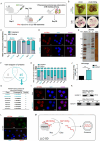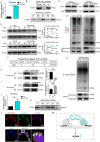Exosomal lncRNA Mir100hg from lung cancer stem cells activates H3K14 lactylation to enhance metastatic activity in non-stem lung cancer cells
- PMID: 40022086
- PMCID: PMC11869636
- DOI: 10.1186/s12951-025-03198-0
Exosomal lncRNA Mir100hg from lung cancer stem cells activates H3K14 lactylation to enhance metastatic activity in non-stem lung cancer cells
Abstract
The mean survival of metastatic lung adenocarcinoma is less than 1 year, highlighting the urgent need to understand the mechanisms underlying its high mortality rate. The role of Extracellular vesicles (EVs) in facilitating the interactions between cancer cells and the metastatic microenvironment has garnered increasing attention. Previous studies on the role of EVs in metastasis have been primarily focused on cancer cell-derived EVs in modulating the functions of stromal cells. However, whether cancer stem cells (CSCs) can alter the metastatic properties of non-CSC cells, and whether EV crosstalk can mediate such interaction, have not been demonstrated prior to this report. In the present study, we integrated multi-omics sequencing and public database analysis with experimental validation to demonstrate, for the first time, the exosomal Mir100hg, derived from CSCs, could enhance the metastatic potential of non-CSCs both in vitro and in vivo. Mechanistically, HNRNPF and HNRNPA2B1 directly binds to Mir100hg, facilitating its trafficking via exosomes to non-CSCs. In non-CSCs, Mir100hg upregulates ALDOA expression, subsequently leading to elevated lactate production. Consequently, the increased lactate levels enhance H3K14 lactylation by 2.5-fold and promote the transcription of 169 metastasis-related genes. This cascade of events ultimately results in enhanced ALDOA-driven glycolysis and histone lactylation-mediated metastatic potential of non-CSC lung cancer cells. We have delineated a complex regulatory network utilized by CSCs to transfer their high metastatic activity to non-CSCs through exosomal Mir100hg, providing new mechanistic insights into the communication between these two heterogeneous tumor cell populations. These mechanistic insights provide novel therapeutic targets for metastatic lung cancer, including HNRNPF/HNRNPA2B1-mediated Mir100hg trafficking and the histone lactylation pathway, advancing our understanding of CSC-mediated metastasis while suggesting promising strategies for clinical intervention.
Keywords: ALDOA; Exosomal lncRNA; H3K14; Histone lactylation; Mir100hg.
© 2025. The Author(s).
Conflict of interest statement
Declarations. Ethics approval and consent to participate: Not applicable. Consent for publication: Not applicable. Competing interests: The authors declare no competing interests.
Figures







References
MeSH terms
Substances
Grants and funding
LinkOut - more resources
Full Text Sources
Medical
Miscellaneous

